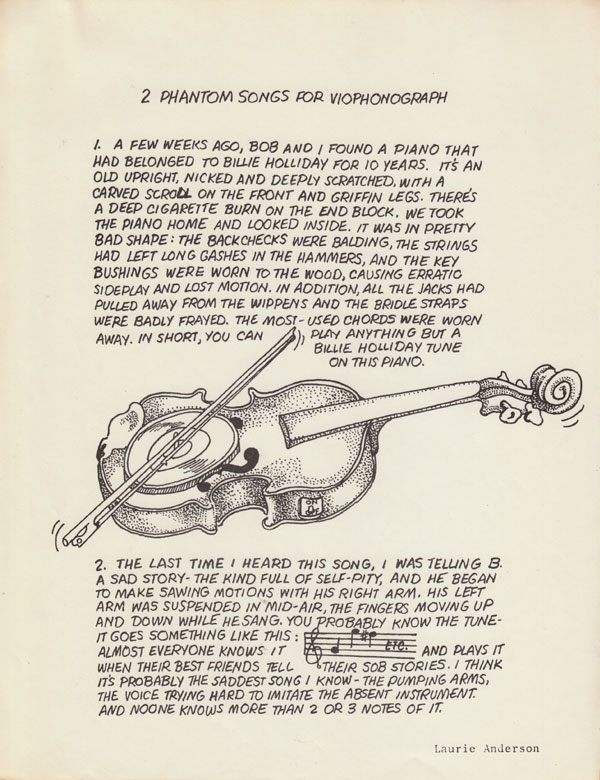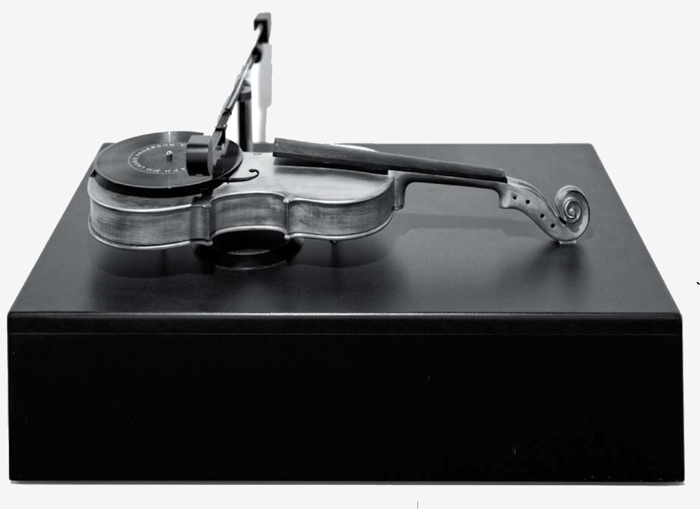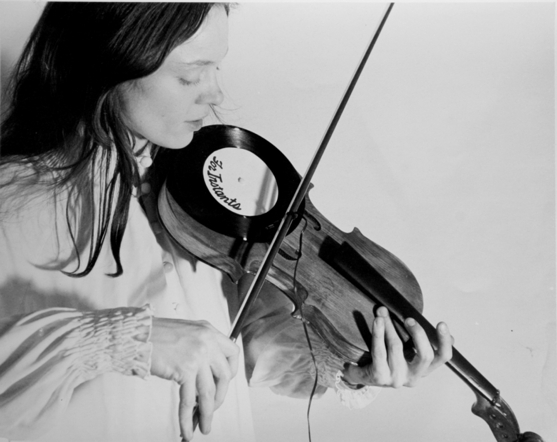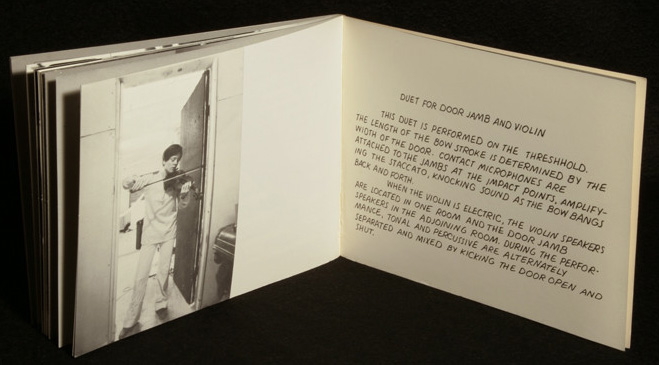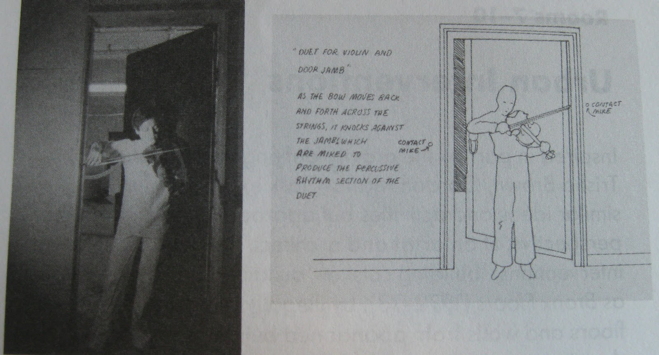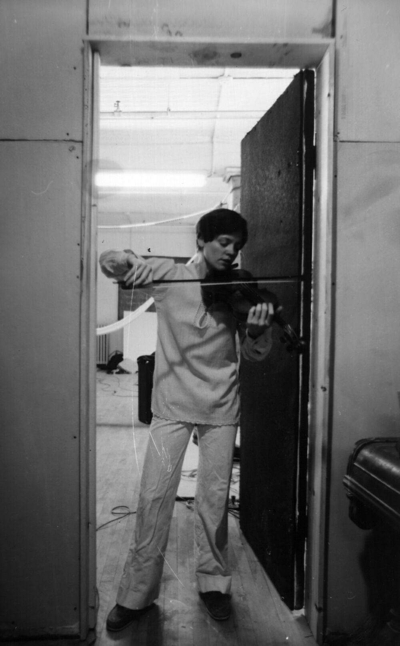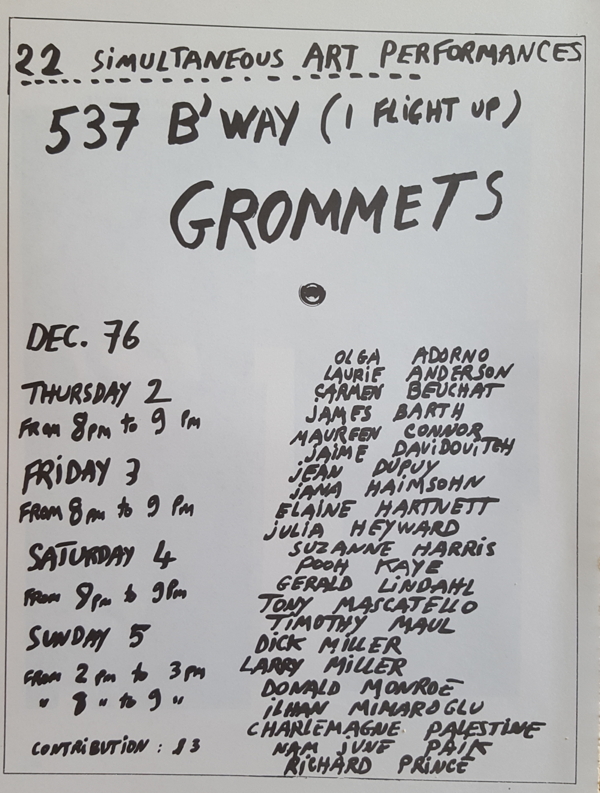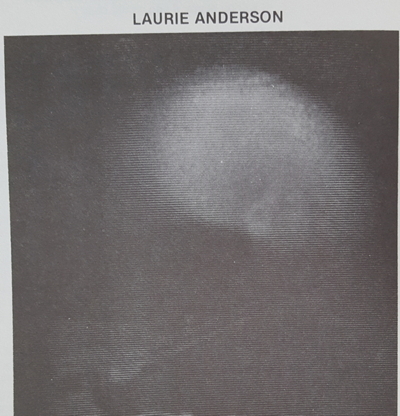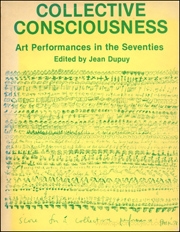listening, auditoria, audiences / écoute, auditeurs, auditoriums : — Studies —
AUDITORIAétude / studyEARLY WORKS (LAURIE ANDERSON)
|
|
Cette série explore les œuvres prenant la notion d'auditorium comme principe / This series is a study about works based on principles of auditoria. • COMPOSING THE NOW (Michel Waisvisz) - 2003 — read /lire • JULES VERNE - (Auditoires, Noise et Aventures Acoustiques / ''Audiences, Noise and Acoustic Adventures'') - XIX° — read /lire • BREATH (Gerald Shapiro) - 1971— read /lire • THE HANDPHONE TABLE (Laurie Anderson) - 1978— read /lire • LAURIE ANDERSON (Early Works 1971-1978)— read /lire • SIX SOUND PROBLEMS (Bruce Nauman) - 1968— read /lire |
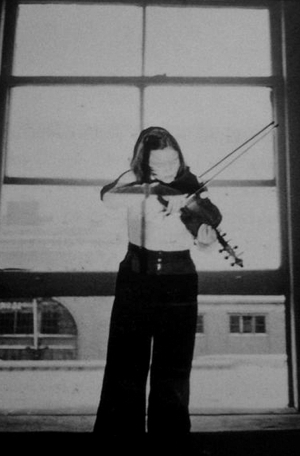
|
Page : — — [Introduction (in French)]
Pages : — — [The Handphone Table (1978)] — [Part 1 : 1971-1972] — [Part 2 : 1973-1974] — [Part 3 : 1975-1976] — [Part 4 : 1977-1978] — [Part 5 : 1979] —
Part 3 - 1975-1976 |
1975(Edit)
| -Moved into new loft -Worked at ZBS Media, Fort Edward New York; became a member of a communal group that had gone through every phase: alternative radio production, gurus, psychedelic drugs, natural foods, kids -Met Bob Bielecki, audio engineer and designer who collaborated on many projects -Began to record THE TALKING BOOK -Photos and audio pieces included in many group exhibitions -Played with "Fast Food Band" in New York City, , (Laurie Anderson, Arthur Russell, Peter Gordon, Scott Johnson, Jack Majewski) |
1974-75 — Fast Food Band(Edit)
| Laurie Anderson also performed with such ad hoc groups as the Blue Horn File (a trio that included Peter Gordon on keyboards and sax and percussionist David Van Tieghem, both of whom would play on Anderson's subsequent albums), the Love of Live Orchestra (idem), and Fast Food Band (which also included Gordon), playing in both art venues like The Kitchen or punk haunts like The Mudd Club. |
— — I had a very short-lived band. A fast food band, and we did some things about a year and a half ago mostly as a joke. I was invited to be in a series that I thought was going to be sort of an art performance thing, and I wanted to do something. I wanted to just have a rock band like every one else on the block, you know, with a drummer and all. We only rehearsed about eight times and then just did three songs. I was the lead singer and since I’ve never sang at all before it was really terrifying. I wanted to do something like that, I mean be in that position. I also played electric violin. There was a sax player, Peter Gordon, and Scott Johnson played guitar, and Arthur Russell made his debut on the drums [, and finally Jack Majewski on bass]. He never played drums before — he is a bass player [and played cello]. And it was really fun. I just discovered that it was really a lot of fun. [I loved Arthur Russell’s sense of panic, and that he was always much more worried than anybody else. Your heart kind of goes out to someone who looks like they’re going to fall apart. But he was also very, very funny, and dark. […] And he was more taken with Talking Heads. [The Fast Food Band] helped me a lot on arrangements. The first time we played the reggae-like song for Chris Burden, It’s Not the Bullet that Kills, It’s the Hole and that was like…it’s gone through a couple different versions at this point but it had real art subject matter. And there was also a fast food blues about what to do with your old art and sort of a blues recipe song. There was a song for a friend of mine who to me is the Doris Day of the art world, smiling sort of, you know, goodie-goodie, which hit me at sort of an odd angle. Because a lot of my work…I mean it wasn’t tortured and it wasn’t really theoretical; so at any rate, there was a song dedicated to him. It was a real nasty song and I felt good about doing it; and then after that sort of purge, I mean getting rid of all the stuff, I started to do other kinds of music and things that I was much happier about myself rather than just doing it totally ironically. — (Laurie Anderson, Interview by Kate Horsfield and Lyn Blumenthal, 1977, published Apr. 2006, Fnews, The School of the Art Institute of Chicago) |
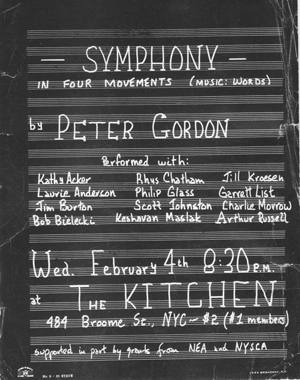 (Poster, The Kitchen, Feb. 4, 1976 - with , Philip Glass, Laurie Anderson, Rhys Chatham, etc.) [Listen to one movement of the Symphony - "Juvenalia"] [Listen to one movement of the Symphony - "Chamber Disco"] [Listen to the whole the Symphony - 5 mvts - (and see below)] | 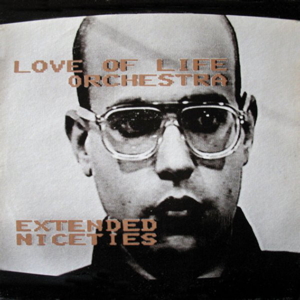 (LP Love of Life Orchestra, Extended Niceties, 1980) |
Love of Life Orchestra was created by Peter Gordon (sax, keyboards, composition) and David Van Tieghem, a talented, smart-aleck avant-garde percussionist with ties to new music composer Steve Reich. Both have gone on to greater fame as elder statesmen of the downtown music scene in New York, but these early works stand as an important developmental chapter. Gordon’s concept for the Love of Life Orchestra dates back to the mid-’70s. He wanted to create a “democratic music,” where people coming from all sorts of backgrounds – classical music, rock music, poetry, visual art – could play music together. Gordon’s education included time spent studying under the experimental composers Robert Ashley and Terry Riley during a particularly legendary time at Mills College in California in the ’70s, before moving to New York City for a rough-and-tumble informal education in art, poetry and music. — Collaborators on their recording Extended Niceties have included Arto Lindsay and David Byrne — Early members of the band included Laurie Anderson (electric violin), Blue Gene Tyranny (keyboards), Ken Deifik (harmonica), Scott Johnson guitar, Rhys Chatham (flute), Peter Zummo (trombone), Arthur Russell (cello), Kathy Acker (vocals), and Jill Kroesen (vocals). Gordon performed his first symphony, Symphony in Four Movements, at The Kitchen in New York in 1976, with a band that included Russell, Philip Glass, Laurie Anderson, and Rhys Chatham, and formalized his Love of Life Orchestra in April 1977, initially a 12-musician group, combining disco, electronic, pop and jazz elements with experimental music. |
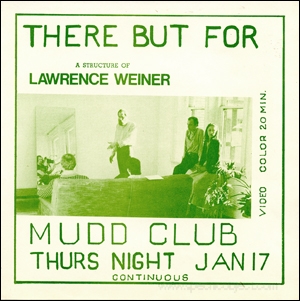 There But For : A Structure of Lawrence Weiner (Mudd Club) [Source] | 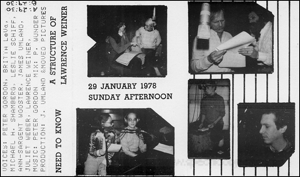 Need to Know (Lawrence Weiner, Peter Gordon, Britta LeVa, Michael Shamberg, Leslie Schiff, Ann-Sargent Wooster, James Umland, Juliet Weber) [Source] | 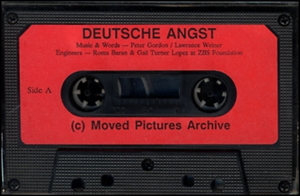 Deutsche Angst / The Memories of Stu Irwin (Lawrence Weiner, Peter Gordon) [Source] [Listen to the audio cassette] |
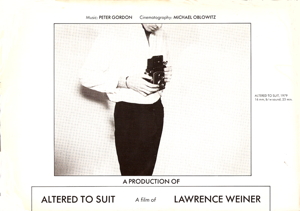 Altered to Suit (a film by Lawrence Weiner with Peter Gordon) [Source] | 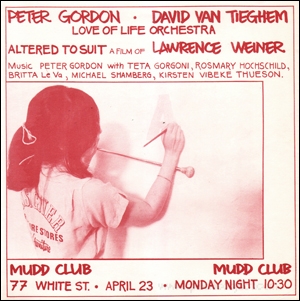 Lawrence Weiner, Peter Gordon, Love of Life Orchestra) [Source] | “ — — The Love of Life Orchestra was founded on the coexistence of multiple musical orientations,“ Gordon explains. “Counterpoint is central to my music, and prevalent in all five movements of Symphony No. 5. Each voice maintains its integrity and forward motion, but intersecting voices illuminate harmonic and rhythmic dimensions that are shared and larger than any single voice. This is both a musical and social concept: counterpoint developed in Europe during the Enlightenment, when multiple voices needed to coexist, and be heard, for society to function.“ |
PETER GORDON - SYMPHONY (1976)
1975 — Self-Portrait into the Edge of a Mirror(Edit)
— — 1974 — Museum of Contemporary Art, Chicago
| 4 gelatin-silver prints 28 x 29,5 cm each (Jedermann collection, USA - Fotomuseum Winterthur, Swizerland) |
| a photographic work, relating perhaps to the psychiatry scene (following scenes from the Dearreader film). — — shown in the collective exhibition : "Self-Portrait", Fine Arts Building, New York, Susan Pensner (curator), 1975. — — shown in the exhibition : "Laurie Anderson, Works from 1969 to 1983", October 15-December 4, 1983, Institute of Contemporary Art, University of Pennsylvania, 1983. |
(Click to enlarge)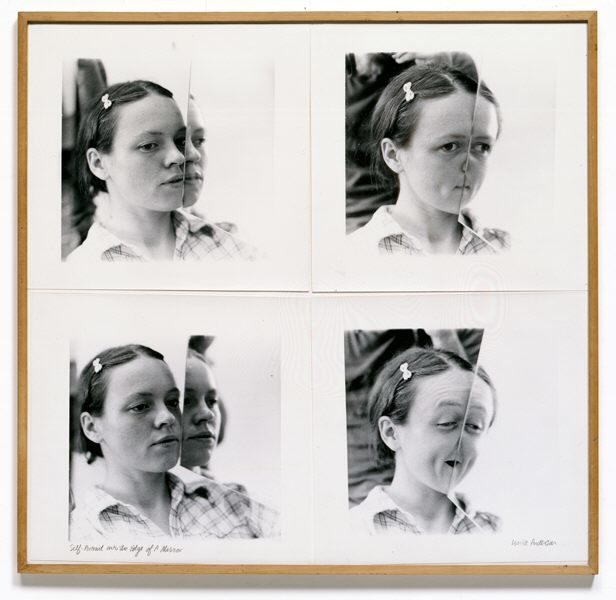 |
1975 — Viophonograph(Edit)
— — (soon)
1975 — At the Shrink's(Edit)
— — installation held at Holly Solomon Gallery, May 11- June 4, 1975
— — 1975 - video projection onto small clay figure with audio
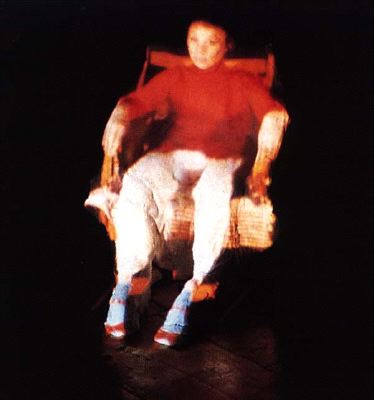 | 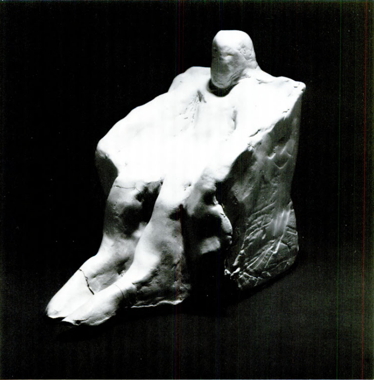 (Photo credit : Scott Bowton) | At the Shrink's, 1975 Super 8 film loop (3:13) and clay 8 x 4 inches — — [Watch an excerpt of the video loop] At the Shrink’s : a little mud figure appears covered by a video image of Laurie at the psychologist, creating a sort of false or fake hologram with sound : a recorded story. The idea of materializing in 3D the two-dimensionality of the image returns in several of her performances where an image sent from a projector envelops the performer’s human figure dressed in white. |
| Anderson positions the eight-inch tall clay figurine in the corner of a gallery and projected onto it a Super-8 film of herself sitting in a chair (giving a two-dimensional image and three-dimensional form) : a clay "sculpture" that had been carefully molded to conform to the proportions of her filmed body. An audio recording of a story about a psychiatry session accompanies the projection, and the video-projection figurine looks as if it is talking. She is telling an anecdote about a session with her psychiatrist. Anderson eventually comes to the conclusion that she and the psychiatrist see things from a totally different angle, both literally and figuratively. From then on, visiting the psychiatrist becomes superfluous. This installation, which seems to offer an alternative to Anderson-the-live performer, later informs Anderson’s development of “Dal Vivo” (1998). Here, the intersection of body, projection, and no voice (or body, projection, and voice as in At the Shrink’s where voice constitutes subjectivity), foregrounds the constructedness of the body and voice as temporal, ephemeral, and surface entities. As projected, flickering images and sounds that exist only as long as the mechanics of the projector and the duration of the films continue, the body and/or its voice are fragile entities that only gain a sense of substance and depth via the sustained illusion of the visible. The projection is a kind of staging, a décor in which the narrative has a natural place. Anderson plays with the space in which the projection is shown : a game of scaling up and down whereby the space in which the story takes pace is eventually relativized. Everything seems different from what it is in reality, both in the narrative and in the images shown. Part of the point of this installation, said Anderson, was "to make someone else talk for me . . . it was a way of doing a performance without being there". It was a surrogate for the performance artist's own body, parroting back words pre-recorded by the "real" Anderson. The conceit of At the Shrink's —"doing a performance without being there"— meant that a key element of "performance art" as such was attenuated. After all, one of the most important notional definitions of performance is that it is predicated on the presence of both performer and audience in a particular time and particular space, on the embodied immediacy of the performance event, on "live gestures". |
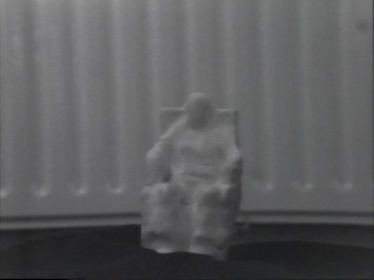 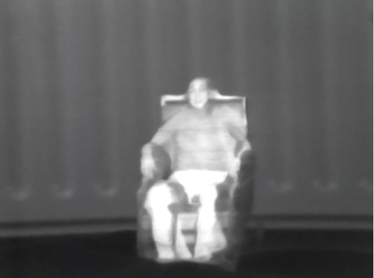 | On this example, the moulded clay is positioned on the ground in front of a radiator, giving you an idea of the scale. |
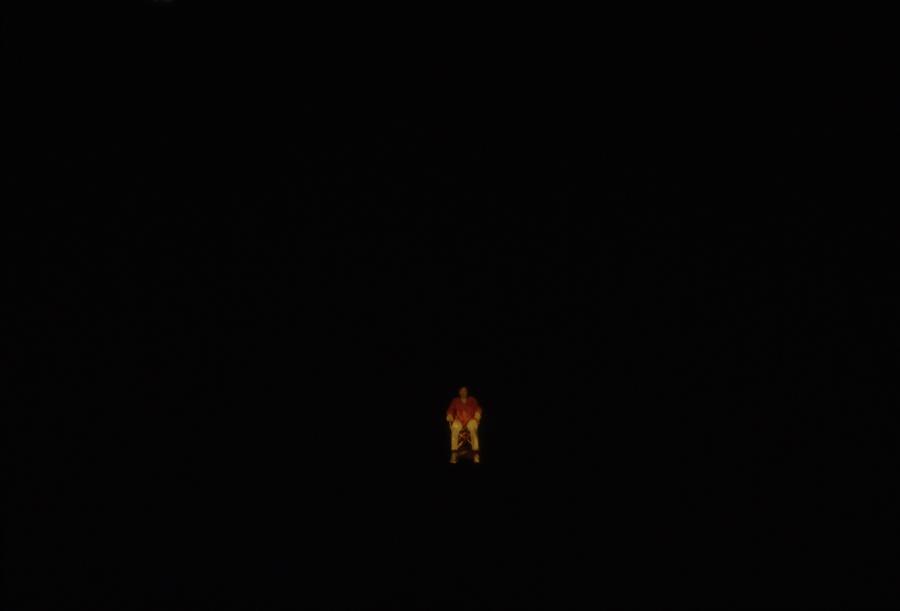
— — “A while ago I spent some time seeing a psychiatrist and I’d get to her office about eight in the morning and sit down. She was sitting in a corner and on one side of her was a window and on the other side a mirror. And she could tell by slight movements of my eyes whether I was looking at her or out the window or at the mirror. And I looked at the mirror a lot and one of the things I noticed was that on mondays it was perfectly clean and clear but by Fridays it was covered with lip marks. And this was a process that was surprising at first and then gradually I got used to it and eventually I started to depend on it. Then one day, in passing, I said, “It’s like the lip marks that appear on your mirror.” And she looked at the mirror and said, “What lip marks ?” And I realized that because of the way the sun was coming in through the window and hitting the mirror that she couldn’t see them. So I said, “Why don’t you get up and sit in my chair ? You can see them from here”. So she got up and I had never seen her out of her chair before [She could actually walk !] and she came and sat in my chair and she said, “Oh! Lip marks !” The next time I saw her was the last time. She said that she’d discovered that her twelve year old daughter had been coming into her office during the week and kissing the mirror and that the maid would come in over the weekend and wash off the marks. And I realized that we were seeing things from such literally different points of view that I’d never have to see her again.” — (Laurie Anderson) |
— — This small, animated sculpture [a wee homunculus carved out of light, according to Eu Jin Chua], is typical of Anderson’s style in that it combines the most commonplace (visiting a psychiatrist) with the most strange (lip marks) : « a mixture of the most mundane things with a fabulous twist on them » (Laurie Anderson, in Stories of the Nerve Bible). The viewer walks into a dark room and towers over the tiny figure of Anderson seated in a chair, talking. The image is amazingly lifelike in its subtle movement of hands and feet. In addition to being a visual pun (« shrink »), the image captures what Anderson was feeling like at the psychiatrist’s office : diminished and constrained. The psychiatrist is out of touch with her own body (« She could actually walk ! »), out of touch with her daughter, out of touch with her sexuality (lip marks), and out of touch with their patient. While there are clear parallels between the figure and the narrative, there is also an opposition between the image and the text. The image remains static, caught in the psychiatrist’s chair, repeating her story ad infinitum. On the other hand, the character in the text is dynamic and empowered (« I realized… I wouldn’t have to see her again »). — (Jessica Prinz, It’s Such a Relief Not to Be Myself : Laurie Anderson’s Stories from the Nerve Bible, In Sidonie Smith & Julia Watson (Eds), Interfaces : Women / Autobiography / Image / Performance, Ann Arbor : The University of Michigan Press, 2002) |
1976(Edit)
| -Received a grant from the Gallery Association on New York State -Recorded songs at ZBS Media; Peter Gordon produced. -Worked with various downtown musicians including Arthur Russell, Scott Johnson, and Rhys Chatham. -Met and hung out with a lot of expatriate American artists in Europe. -Exhibited sculptures and installations in many group shows. |
1976 — Duet for Door Jamb and Violin(Edit)
1976 — Engli-SH(Edit)
— — Engli-SH — First performance in a foreign language - Berlin Festival, Akademie der Kunst, Berlin, Germany, 1976
—— Engli-SH — Louisiana Museum, Humlebaeck, Denmark, 1976
| In 1976, Anderson prepared a new piece for the Berlin Festival, called Engli-SH. Knowing little German, she attempted a performance that explored the areas between the languages, emphasising ’s’ (actually ‘z’ in German) and ‘sh’ sounds. At first, she appeared before her audience with simultaneous slide projections of German translation as she spoke. But, after a while the subtitles went out of sync, and the performance took on a new rhythm. Almost every word had a ‘zzz’ sound in it, which became the buzzing of a fly, the noise of snoring, the resonance of bad violin playing. (Curiously enough, small sections of the audience responded by locking arms and replying with the own ‘zzz’ sounds.) Anderson also played a violin as she ran back and forth between two microphones, merging the images of crossing langage carriers and violon playing. The staccato sounds of the violin rapidly going in and out of the microphone’s range increased until they resembled the frenzied report of a machine-gun. Anderson then stopped to tell a story about carrying a violin case in Chicago. She performed her violin duet, and on an up-stroke she released the bow, which sailed to the wall, hitting a projected image of an apple, which transformed into the character of William Tell, as other images began to multiply. — (Mel Gordon, Performance Artist / Art Performer : Laurie Anderson, In Contemporary American Theatre, edited by Bruce King, Palgrave Macmillan, 1991, pp. 198-199) |
1976 — Style and Process (Fine Arts Building)(Edit)
— — (soon)
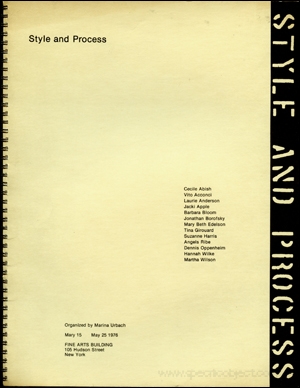 (Catalog of the collective exhibition, Fine Arts Building, New York, May 15 - May 25, 1976 ) | t | Style and Process Organized by Marina Urbach. Artists include Cecile Abish, Vito Acconci, Laurie Anderson, Jacki Apple, Barbara Bloom, Jonathan Borofsky, Mary Beth Edelson, Tina Girouard, Suzanne Harris, Angels Ribe, Dennis Oppenheim, Hannah Wilke, and Martha Wilson. With an interview between Roberta Bernstein and Marina Urbach. Writing by Timothy Binkley, Lucy R. Lippard, Susan Sontag. Includes conversations between many of the artists and Urbach and other artists in the exhibition. |
1976 — Grommets #3 (Jean Dupuy)(Edit)
— — Performance, from 2 to 5 Dec, 1976
| — — "J’ai choisi de travailler avec les limites physiques de la cabine en m’asseyant sur une chaise coincée entre le mur et la cloison en toile. Je jouais le violon de sorte que l’archet pouvait seulement être déplacé d’environ 1,25cm de part et d’autre. Le son était essentiellement percussif, avec de courts bips tonaux. Je crois que pour le public, le spectacle devait avoir une espèce de côté « télé » - vous les voyez, mais ils ne peuvent pas vous voir. Quand je ne pouvais pas être présente dans la cabine, j’y plaçais une doublure. C’était une petite diapo d’une émission de télé - Mary Hartman assise à sa table de cuisine. Une statuette en argile de Mary était placée juste devant la diapo de sorte qu’elle semblait sortir de la télé, comme au 21ème siècle, quand la télé sera réellement en hologrammes à trois dimensions, que toutes vos vedettes préférées débouleront dans vos maisons et Mary Hartman (la vraie) Mary Hartman (l’hologramme) sortira pour s’attabler dans votre cuisine, boire votre café, et tailler une bavette. Voilà, c’est ça, un grommet." — (Laurie Anderson, In Jean Dupuy, catalogue À la Bonne Heure, Semiose éditions / Villa Tamaris Centre d'Art / Villa Arson Nice, 2008, p. 59) | — — One of the thing I like about Jean Dupuy’s Grommets show wad its step-right up, corny feeling. Everyone installed in their own little booth, singing, dancing, entertaining. It came close to nightmares I have about Soho - everyone’s at home working away and you never really know if it makes a difference to anyone « out there » of not. I chose to work with the physical limitations of the stall and sat in a chair squeezed between a wall and a divider. I played the violin so that the bow could move only about half-inch back and forth between the walls. The sound mas mostly percussive, with short tonal bips. After about an hour of doing this, I looked out of my grommet and saw a long lines for other holes but none near mine. I had no idea whether people had been there or not. I think fot the audience, the show must be have had a kind of TV quality - you can see them, but they can’t see you. When I couldn’t be in the stall, I put a stand-in there. It was a small slide taken off a TV - Mary Hartman sitting at her kitchen table. A clay figure of Mary was placed slightly in front of the slide so she seemed to be coming out of the set, like in the 21st century when TV will be 3-D and holograms of all your favorite TV stars will ooze out into your house and Mary Hartman (real) Mary Hartman (hologram) will clump out, sit at your kitchen table, drink your coffee, and chew the fat. Now that’s a grommet. — (Laurie Anderson, In Jean Dupuy, Collective Consciousness, Art Performances in the Seventies, Edited by Jean Dupuy, Performing Art Journal Publications, New York, 1980, p.155) |
| — — A few blocks up from Canal, in Jean Dupuy’s loft, another performance turning private info public action was going on all weekend. But while Geoff Hendrick’s activity was a 12-hour process available for continuous viewing, Grommets presented around 20 different events simultaneously for an hour. Each event, taking place in its own discrete area of a two-story structure, was masked by muslin and visible only through a grommet. A grommet is a metal eyelet which reinforces a hole in fabric. This is the second Dupuy’s grommet pieces ; the first, at PS1 earlier this fall, presented simultaneously activity in one room which could be viewed through grommets in the canvas doorhanging. Because the structure generated an aura of voyeurism, it’s not surprising that many of the pieces were about private activities, or private parts. […] Thursday night I heard Pooh Kaye was throwing dirt around with some kind of fantastic machine, and I saw Laurie Anderson’s tiny 3-D projection of Mary Hartman. Saturday night, Anderson was playing one violin note, obsessively, and the Mary Hartman grommet was taped over. Kaye was throwing punches, moving her body around abruptly, moving close to the grommet, punching at it, moving away. — (Sally Barnes, first published in Soho Weekly News, Dec. 9, 1976 ; In Jean Dupuy, Collective Consciousness, Art Performances in the Seventies, Edited by Jean Dupuy, Performing Art Journal Publications, New York, 1980, p.48) |
1976-77 — For Instants(Edit)
—— from FOR INSTANTS, Museum of Modern Art, NYC, 1976
—— from FOR INSTANTS, Whitney Museum of American Art, NYC, 1976
—— from FOR INSTANTS, Brockport College, Brockport, NY, 1976
—— [Fast Food, Artists Space, NYC]
—— from FOR INSTANTS, Skidmore College, Saratoga, NY, 1976
—— from FOR INSTANTS-3 », Philadelphia College of Art, Philadelphia, PA, 1976
—— ?, California Institute of the Arts, Valencia, 1976
— — Laurie Anderson performed various instalments of the 12-part series between 1975 and 1978.
For Instants was a series of performances that Laurie Anderson began in 1974 [?]. This particular presentation was a work-in-progress which focused on the rhythms of talking, with a soundtrack created from spliced audiotape and live violin. Anderson’s signature projections appeared in the background.
| Seule sur scène, Laurie Anderson expérimente un harmonizer en modifiant sa voix, deux techniciens l'accompagnent : un pour le son et un pour les images. C'est à cette époque qu'elle commence à se familiariser avec les machines qu'offre la technologie. |
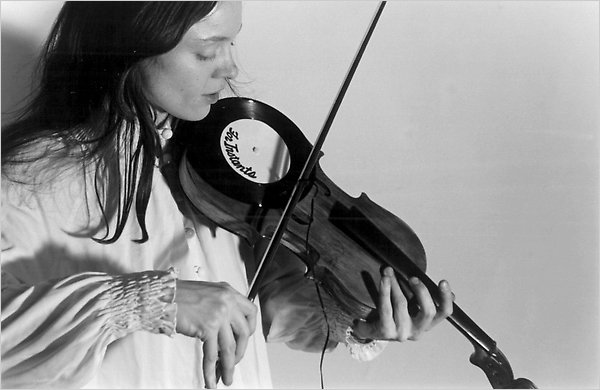 | The 45 minute piece For Instants (1976) incorporated explanations of the technical difficulties in making the work plus postmodern distinctions between ‘what happened’ and ‘what I said and write about what happened.’ The consistent component of these works is the manipulation of image, body, voice, and source. Using the body to intersect projection as a site of suture or rupture continues with For Instants: Part 3, Refried Beans (1976), a project that incorporates film, the playing of a violin, recorded stories, and live stories. The most noted element of this piece, though, involves a corridor of projections from three projectors in which Anderson moves her body inside, outside, and through. Her body becomes a part of either the film projection or the space between the screen and the projector. Depending on her position, the image on the screen changes. By interrupting the film and creating shadows among the projected display of images, or continuously walking in and out of shadows and spotlights and creating both positive and negative images against the video screen backdrop, Anderson uses her body to interrupt and intercept filmic and projected images so as to affect how and what one can see in the performance environment. In what seems to be a shift to performances that focus more on the physical body, projected images, and light rather than the voice, the recorded and live voice as well as the playing and sound of the violin (a representation or extension of body and voice) provide constant variables that alter and affect the visual. |
Next Part 4 : 1977-1978(Edit)
Pages : — — [The Handphone Table (1978)] — [Part 1 : 1971-1972] — [Part 2 : 1973-1974] — [Part 3 : 1975-1976] — [Part 4 : 1977-1978] — [Part 5 : 1979] —
Page : — — [Introduction (in French)]

